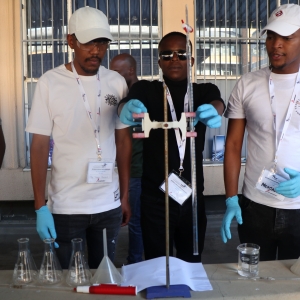NRF-SAASTA invited Komatsu and Harmony schools’ educators to participate in an educator workshop
30 November 2023
Educators around the country are encountering challenges when facilitating physical sciences and life sciences lessons and this is mainly due to the lack of equipment and inability to conduct experiments. To address this challenge, NRF-SAASTA called upon key stakeholders to collaborate and host a workshop focusing on empowering and supporting natural sciences, life sciences and physical sciences educators with curriculum related content. The structure of the workshop was participatory in its nature, which included hand-on activities, and peer-to-peer learning while being facilitated by experts.
The educators were warmly welcomed by being exposed to an all-day robotics session, which was facilitate by UNISA Science Engagement Centre (USEC) and led by Dr Patricia Gouws. A constructivist exercise – building, disassembling and rearrangement was the order of the day, while learning took place through trial and error as well as repetition. Educators had a fun affair with playing with robots and unearthing importance of making and tinkering as a way of transforming learning into a fun activity in the classroom to foster creativity and teamwork among learners.
Educators were then split and grouped according to the learning areas of they teach. Starting with natural sciences educators, the play and hands-on activities continued throughout the week whereby they got exposure in an intensive experience of electricity experiments which was facilitated by 4IR Solutions who developed electric kits which the educators were using. In using kits educators were able to conduct the experiments outlined in the Curriculum Assessment Policy Statement (CAPS) document. The educators were then exposed to astronomy and space science topics where the South African Astronomical Observatory (SAAO) facilitated an interesting workshop focussing on earth and beyond. The objective was to create excitement, and to shed light about attributes of Earth and what lies beyond to help educators understand the science behind the cosmic activities. “The sky is a resource for learning and teaching” said Sivuyile Manxoyi (SAAO). The session also included tips on how to build a homemade telescope as well demonstrating how astronomy and space science has improved the livelihood of humans by fostering innovation, creativity and technological developments.
The life science group of educators had the pleasure of attending workshop both at the NRF-SAASTA office as well as at excursive visits to the research and pathology labs of the National Zoological Gardens. The South African National Biodiversity Institute (SANBI) facilitated the educator workshop. The focus areas of this workshop was biodiversity, genetics and microorganisms. This was a wonderful opportunity for educators to engage with researchers, lab technicians, etc. and uncover meaningful insights about mitosis, different phases of a cell, meiosis; to the concepts of genetic, species and ecosystem biodiversity. The underlying aim was to equip educators with information to advocate for conservation and protection of diversity in schools while learners are being fascinated by South African diversity.
Lastly, the physical sciences group of educators were given opportunity to be engaged by well-experienced University of Limpopo School of Physical and Mineral Sciences lecturers through a collaboration with the South African Institute of Physics (SAIP). Using the matric diagnostics report as well as a pre workshop survey topics of the workshop determined. This meant educators outlined the areas where they required support and lecturers addressed them. The learning areas included chemistry and physical sciences experiments, electrochemical, galvanic and electrolytic cells among other things. Interestingly, the workshop was dialectic in nature whereby educators were debating and exploring different methods of explaining science concept leaving the white board filled drawings and explain. Allowed a positive and content intensive interaction. The examples were drawn from various practical real life situations to unpack what the theory states. The session was summed up with a series of experiments being conducted, resulting in informative and fun experience for educators.
Three (3) educators from twenty eight schools were invite to participate in workshop, granting each school an opportunity to send delegates for each of the natural sciences (grade 8-9), life science (grade 10-12) and physical science (grade 10-12) workshops. The robotics workshops purposefully structured in a way that all educators are involved in the activity and embracing its crosscutting nature workshop demonstrated how the sciences are interlinked as well as robotics can be used to various topics in the classrooms. The four-day long workshop concluded with a jaw-dropping surprise where educators received educational resource materials on behalf of their respective schools. The materials included a Lego spike prime robotics kits (including a tablet), a set four electricity kits, posters, and various content materials which educators can use facilitate learning and teaching in the classroom. In the closing remarks by Mr James Tlhabane (NRF-SAASTA) he encouraged the educators stay committed as they are transforming many lives through teaching science at schools. He also thanked the educators for participating, sharing and engaging in the various activities throughout the four days. What underpinned the workshop was the passion and love for science and the recognition that educators a key stakeholder in value chain of science education.


 The South Africa Agency for Science and Technology Advancement (SAASTA) is a business unit of the
The South Africa Agency for Science and Technology Advancement (SAASTA) is a business unit of the